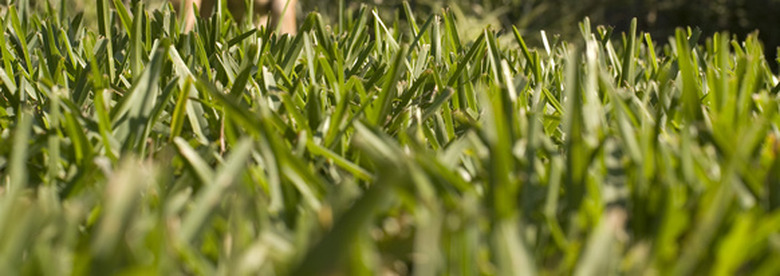How To Troubleshoot Yellow St. Augustine Palmetto Grass
Things Needed
- Nitrogen lawn fertilizer
- Water
- Iron sulfate foliar spray
- Soil test kit
Yellowing turf grass is a sign that micronutrients are lacking in the soil. Most common among deficiencies for St. Augustine grass is iron, according to Texas A&M University. A lack of iron, or an inability to uptake the iron in the soil, is a condition called iron chlorosis, is especially common in St. Augustine grass growing over alkaline soil above 7.5 pH. Foliar applications of iron sulfate, regular fertilization and ample water will help rule out and resolve this common cause of yellowing lawn grass. Beyond this, a soil test will be needed to pinpoint any nutritional imbalances or persistent toxicity in the soil.
Step 1
Correct for an iron deficiency in the soil by spraying your St. Augustine grass with an iron sulfate or iron chelate product in the spring, summer and fall. Apply according to label dosing directions and repeat as recommended to correct or manage the problem.
- Yellowing turf grass is a sign that micronutrients are lacking in the soil.
- A lack of iron, or an inability to uptake the iron in the soil, is a condition called iron chlorosis, is especially common in St. Augustine grass growing over alkaline soil above 7.5 pH.
- Foliar applications of iron sulfate, regular fertilization and ample water will help rule out and resolve this common cause of yellowing lawn grass.
Step 2
Fertilize your St. Augustine grass once a month to every other month, from spring through late fall. Use a nitrogen-rich lawn fertilizer formulation. Apply according to the label dosing directions and do not exceed 1 pound of nitrogen for every 1,000 square feet of lawn at each feeding. Water well after applying to drench the soil down to 6 inches, wetting the main root zone with the nutrient-laden water.
Step 3
Feel the thatch and the soil for moisture. St. Augustine grass can discolor with drought stress. If the thatch feels completely dry to the touch, water the grass immediately until drenched at least 6 inches down to relieve stress on the roots. Apply a minimum of 1 inch of water per week in one or two sessions to keep the lawn well hydrated. In dry climes or summer, more water will be needed.
- Fertilize your St. Augustine grass once a month to every other month, from spring through late fall.
- Apply a minimum of 1 inch of water per week in one or two sessions to keep the lawn well hydrated.
Step 4
Raise the mowing height on your St. Augustine grass to prevent scalping and improve the green color. St. Augustine should always be mowed between 1 and 3 inches. Raising the mower height an inch taller will improve the green and reduce the growth stress on the plants.
